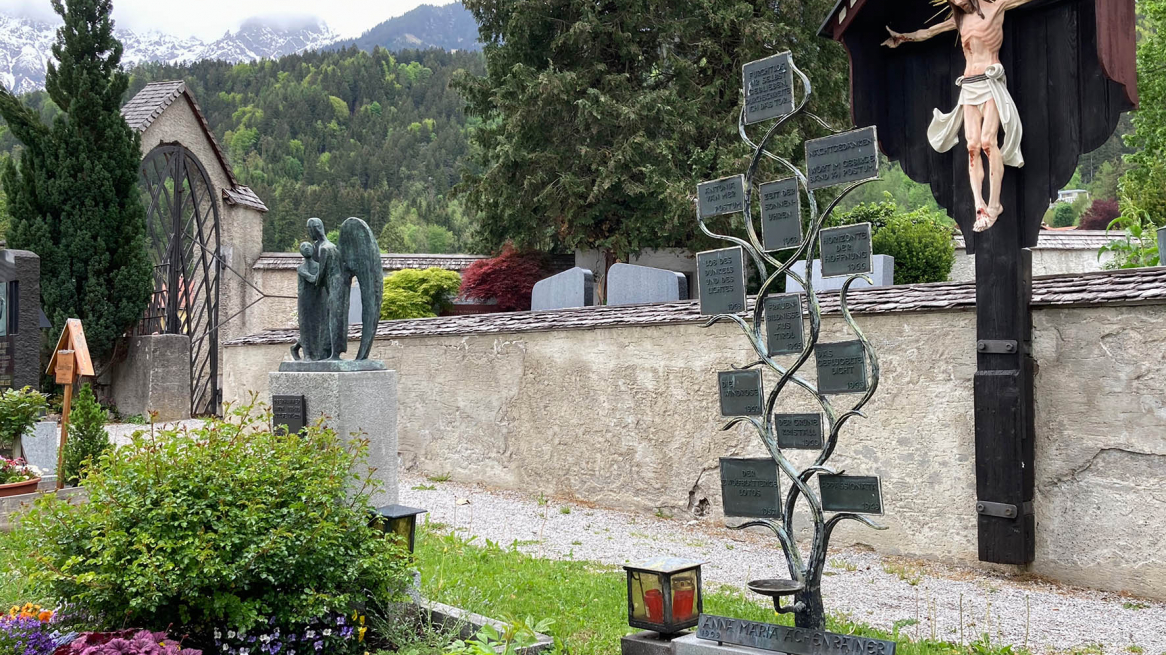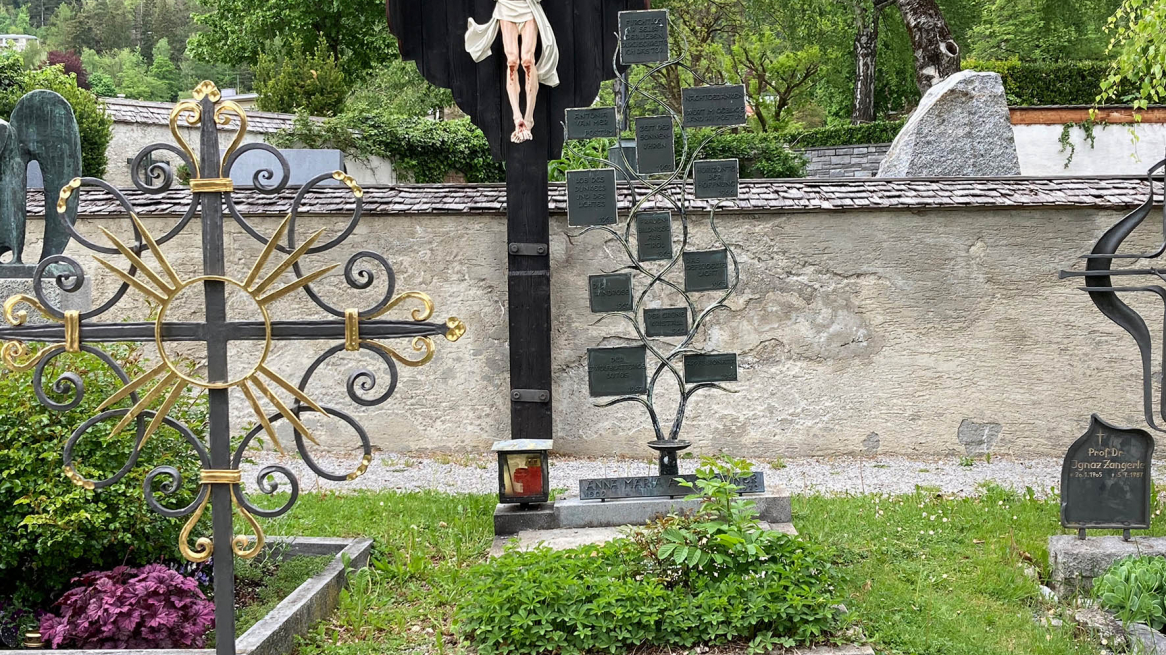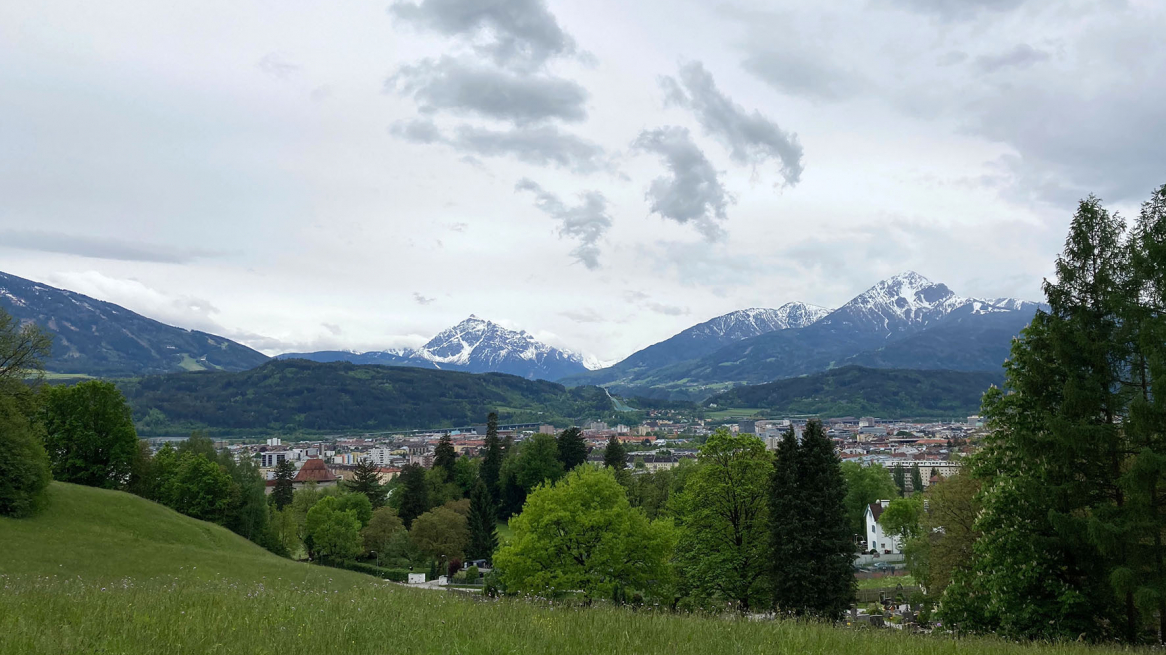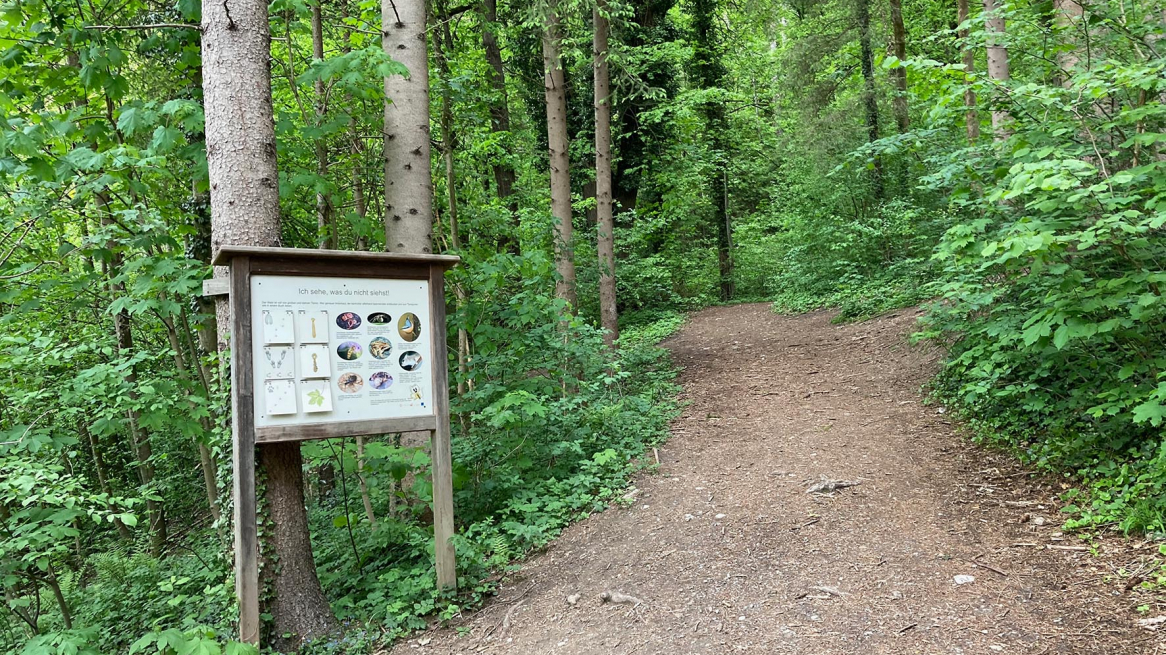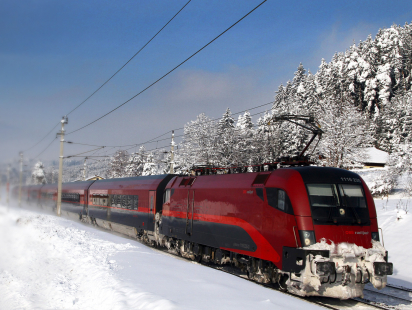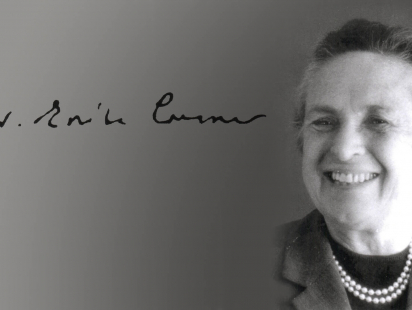Cemeteries are places of mourning, farewell and remembrance. But they are also places of peace, of contemplation. Walking among the graves, taking a seat on a bench - I like to do that again and again. Cemeteries, graves tell us a lot if we pay attention. Some graves are so special that you don't forget them. One such grave is that of Anna Maria Achenrainer.
BOOKS AT THE GRAVE
I came across it during my research for the book "111 places in Innsbruck that you must have seen". A friend told me about a very special grave at the New Cemetery in Mühlau. No, I am not talking about Georg Trakl! I do walk in his footsteps from time to time. But in this case it is not about the famous poet, but about the meanwhile forgotten writer Anna Maria Achenrainer (1909-1972). She took her books to her grave in the truest sense of the word
ANNA MARIA ACHENRAINER
Correctly read: not into, but onto the grave. Instead of a wrought-iron cross, the titles of her books appear. Born in 1909 in Pfunds in the Upper Inn Valley, Achenrainer experienced a difficult childhood. After the death of her father, who was killed in the First World War, the girl spent several years in an orphanage in Scharnitz. She attended the teacher training college in Innsbruck and took a job at the post office.
At the same time, Achenrainer began writing stories and poems, some of which appeared in newspapers such as the Tiroler Volksbote or the Tiroler Anzeiger - and of course in book form.
A SIGNIFICANT GAIN
The author was actively involved in the cultural life of Innsbruck. She was a founding member of the authors' association Turmbund and participated in the Austrian Youth Culture Weeks founded in 1950. In the same year, she received the recognition award for her poetry collection "Appassionata" as part of the Austrian State Prize.
"The Tyrolean poet Anna Maria Achenrainer at last is already as an overall appearance pleasingly above the average, for the new Austrian poetry a significant gain," was written in the magazine The Furrow about the book of poems. Despite her fame and public recognition - the province of Tyrol honoured Achenrainer with the Cross of Merit in 1970 - the writer is almost forgotten today.
NATURE MAGIC IN MODERN TIMES
The majority of her estate lies dormant in the Brenner Archive Research Institute, on loan from the Tyrolean Provincial Museum Ferdinandeum, which also has a collection. Anyone leafing through her books often encounters a kind of Arcadia, a transfigured image of rural life and a mystification of the Tyrolean cultural landscape.
Achenrainer likes to draw on ancient Greek, ancient Egyptian and Indian mythology. She is sceptical about technology, progress and modernity. This is probably one of the reasons why hardly anyone reaches for Achenrainer's works any more. Themes and form were already out of date after the Second World War. People thirsted for something new, for new beginnings.
CONNECTED WITH THE WORK
But no matter how you judge Achenrainer's poems, her prose, her grave is simply wonderful - I think. It testifies to her deep love of literature, to her attachment to her own work. Every time I wander through the New Cemetery in Mühlau, I stop by to see her and her books, plucking leaves from the tombstone and wiping foliage aside.
The grave site is easy to find once you know where it is: Section B, southwest of the cemetery chapel. This chapel is, like the whole cemetery, a listed building. The cemetery was built in 1926 according to plans by Wilhelm Stigler. The architect unfortunately took an inglorious role during the Second World War by becoming a convinced National Socialist.
Nevertheless, he is responsible for some very remarkable buildings in Innsbruck, including the former "Auto-Garage" on Haller Straße, also built in the 1920s. The building diagonally opposite the Dollinger Inn on the slip road to Mühlau is now used by the fire brigade and the water rescue service.
IN THE BEST OF COMPANY
The New Cemetery Mühlau is also really impressive. Idyllically located, with old shady trees, a cozy devotional place. From here you have a beautiful view of the Mühlau church and the old cemetery - always worth a detour! -, to the village of Mühlau itself and to Innsbruck.
From the cemetery there is a fantastic view of Innsbruck, the low mountain range and the Wipp valley.
Anna Maria Achenrainer is in the best of company here. Not three paces from her rest Ludwig von Ficker, the founder of the magazine Der Brenner, and the famous Georg Trakl. The painter Wilfried Kirschl is buried in the row in front of her.
And if you stroll around with your eyes open, you will come across other names important to Tyrolean cultural life - such as that of the painter Gerhild Diesner or the writers Carl Dallago and Josef Leitgeb.
By the way, I like to combine a visit to the Mühlau cemetery with a hike to the biotope Fuchsloch and via the Schillerweg and the Psenner-Steg back to the city. The bus connections are of course also excellent (line A, 501, 503, stop Mühlenweg)!
All photos: © Susanne Gurschler
TIPS
If you want to know more about literary Innsbruck, I recommend the online encyclopedia Literaturtirol. Also great is "Innsbruck. Ein literarischer Stadtführer" by Iris Kathan and Christiane Oberthanner, published by Haymon Verlag. And of course I recommend my "111 places in Innsbruck that you have to see" (Emons Verlag) to everyone. In addition to a few other literary delicacies and cemetery specialties, there are many, many other wonderful places in Innsbruck to discover in it and with it.
All cemeteries of the city of Innsbruck are listed here. If you are looking for a specific grave site, you will find it here. Additional information about churches, monasteries, chapels and other holy places can be found at innsbruck.info
Rate this article
Show me the location on the map
Innsbruck has captured her heart, and the view of the Nordkette mountains soothes her soul. A journalist, non-fiction author, bookworm, amateur photographer, dog owner and mountain walker #ghostsofinnsbruck
Similar articles
The zoo is at the cradle of my love for Tyrol. It awakened in me the longing…
I commute a lot between Innsbruck and Vienna and I know the advantages of both cities. Many…
The darker and colder it gets outside, the cozier and cozier it gets inside. When, if not…
The physical chemist Erika Cremer (1900-1996) is one of the most important research personalities of the University…

